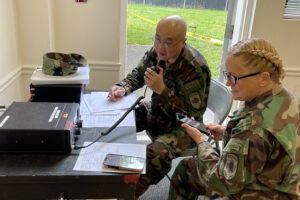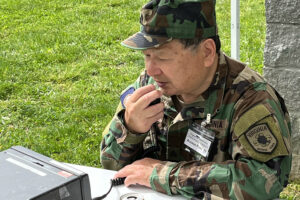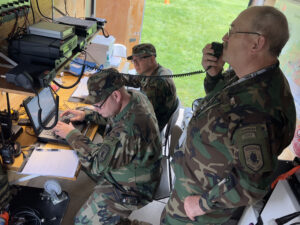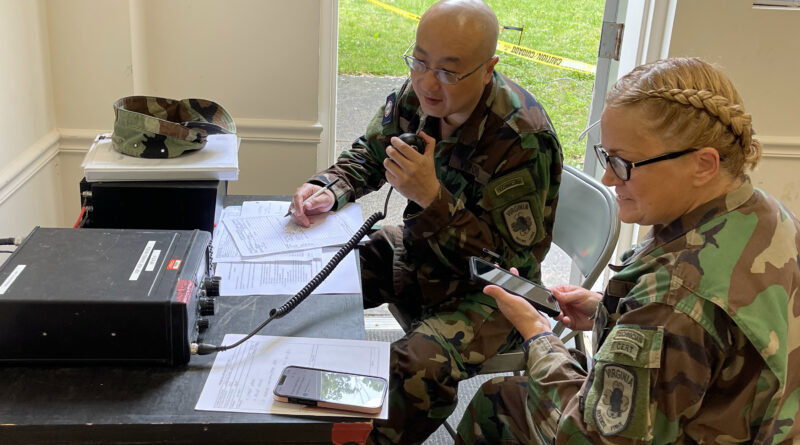Virginia Defense Force conducts statewide hurricane readiness exercise

WARRENTON, Va. – Members of the Virginia Defense Force’s 1st Regiment conducted the “Spring Winds 22” training exercise May 14, 2022, at multiple locations across Virginia to test their incident management assistance, access control and interoperable communication support capabilities. The exercise simulated a severe hurricane and how the VDF would support the Virginia National Guard’s role as a member of the state multi-agency response team.
“The Virginia Defense Force continues to demonstrate why they are such an important part of the Virginia National Guard’s domestic response capabilities,” said Maj. Gen. Timothy P. Williams, the Adjutant General of Virginia. “This exercise is the latest example of VDF leaders making readiness a priority to be sure they are ready to provide the capabilities we might need during a severe weather situation. In addition to ensuring their systems are fully functional, the exercise also helped developed VDF junior leaders, and that sets up the organization for future success and allows opportunities for growth. It is all even much more impressive when you understand they all volunteered their time to take part in the training, and that spirit of selfless service is part of what makes the VDF such a great organization. We owe them a special thanks for everything they do.”
The VDF’s 11th Signal Battalion,1st Regiment operated mobile communication platforms in Warrenton and Lynchburg and high frequency radio, access control and incident management assistance teams in Fairfax, Winchester and Virginia Beach. Personnel from 31st Cyber Battalion, 1st Regiment provided role players to add realism to the training scenario, and the 1st Regiment and VDF Force Headquarters Training and Operations Sections provided exercise control.

The exercise successfully tested the VDF’s communication systems including high-frequency radio voice and data as well as the Virginia Statewide Agencies Radio System and the web-based Web Emergency Operations Center, or WebEOC, used to managed incidents online at the state level.
In addition to testing systems, the exercise itself was a learning experience.
“One goal was to become more familiar with scenario-based exercises, because we have established ‘Spring Winds’ as our annual hurricane scenario exercise, and ‘Highland Guardian’ as our annual winter storm scenario exercise,” explained Col. (Va.) Robin Phillips, commander of 1st Regiment. “Knowing how to handle events that may arise in an emergency is just as important as having tactical and technical proficiency in communications.”
The exercise also provided an opportunity for troops from the cyber battalion to take part in the exercise by running the scenario and providing role players, Phillips said.
The exercise also was a chance for younger VDF leaders to gain valuable experience.
“This was an excellent opportunity for our company grade leaders to test their operational skills, and they knocked it out of the park.” Phillips said. “This gives me a lot of confidence that the VDF will continue to perform at a high level for many years to come.”
Phillips recognized Capt. (Va.) Douglas Easton and 2nd Lt. (Va.) Patrick McCaul from the 1st Regiment operations and training section for planning and developing the scenario along with 1st Lt. (Va.) Michael Perini, the training officer in charge from the VDF Force Headquarters G3 Operations and Training Section. All three served as the exercise officers in charge.
Perini said the exercise strengthened the knowledge and understanding of emergency management procedures and the role that the VDF plays in the support of Virginia National Guard missions.
“The adaptability of the troops during this exercise was outstanding,” he said. “While initially encountering communication challenges due to atmospheric conditions, role players were quick to adjust and find alternative means of message relay and troops were able to demonstrate significant aptitude on several modalities, to include high frequency radio and WebEOC.”

Perini explained the style of exercise illustrated how the communication flows between the VNG during emergency management situations and affords the opportunity for leaders to emerge at all levels.
“A unique aspect of the VDF is that rank does not always indicate experience or expertise with subject matter,” Perini said. “This manner of exercise allows for that expertise to shine through. We had officer candidates briefing the regimental commander on technical and strategic lessons learned, which is an impressive consequence.”
Perini said the exercise was a successful and safe learning opportunity.
“This training was a learning experience for several layers of troops, as many stepped up into more substantive roles,” he said. “We always can improve, and we will do so with after action reports and assessments. Ultimately, training desires for troops to have a valuable and creative educational experience without any safety issues. We happily achieved that outcome with this exercise.”
The VDF MCP is a 7 1/2 feet by 16 feet trailer equipped with multiple radio systems for voice and data communications. Using an MCP, members of the VDF are able to communicate across a variety of radio spectrums with emergency response and public safety organizations as well as amateur radio operators.
VDF personnel providing incident management assistance employ Tactical Communication Packages used for internet connectivity to operate web-based communications like WebEOC used to track missions during emergency response operations.
The VDF is authorized by Title 44 of the Code of the Virginia as the all-volunteer reserve of the Virginia National Guard, and it serves as a force multiplier integrated into all Guard domestic operations. The VDF reports to the Adjutant General of Virginia as part of the Virginia Department of Military Affairs along with the Virginia Army National Guard and Virginia Air National Guard. Members of the VDF volunteer their time for training and are only paid when called to duty by an authorization from the Governor of Virginia.

